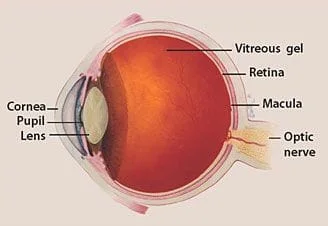Glaucoma is a disease, of the eye, caused by elevated Intraocular Pressure(IOP). Most elevations of pressure are not detected by patients. Cases that are undetected and untreated can do damage to the optic nerve and retinal nerve fibers. It can lead to loss of peripheral vision gradually and in rare untreated cases to blindness. Early detection and treatment can slow or halt the loss of vision.
Types of Glaucoma
Open Angle is the great majority of people. It is the elevated eye pressure, usually doing damage over many years. It can begin in people in their 40's and becomes much more common with each decade of life. It sometimes has a hereditary risk factor. In other words, if you have a few or many family members with it, you are more at risk than the average population and probably should be checked yearly after 40. Many cases have no prior family history. General population should be checked every one to two years for Glaucoma. Probably yearly after age 60. There is nothing anyone can do to prevent it or that caused it. Other than prior eye trauma, no major risk factors have been shown. If detected early and treated most people never lose vision.
The optic nerve

The optic nerve is a bundle of more than 1 million nerve fibers. It connects the retina to the brain. (See diagram above.) The retina is the light-sensitive tissue at the back of the eye. A healthy optic nerve is necessary for good vision.
How does the optic nerve get damaged by open-angle glaucoma?
Several large studies have shown that eye pressure is a major risk factor for optic nerve damage. In the front of the eye is a space called the anterior chamber. A clear fluid flows continuously in and out of the chamber and nourishes nearby tissues. The fluid leaves the chamber at the open angle where the cornea and iris meet. (See diagram below.) When the fluid reaches the angle, it flows through a spongy meshwork, like a drain, and leaves the eye.
In open-angle glaucoma, even though the drainage angle is “open”, the fluid passes too slowly through the meshwork drain. Since the fluid builds up, the pressure inside the eye rises to a level that may damage the optic nerve. When the optic nerve is damaged from increased pressure, open-angle glaucoma-and vision loss—may result. That’s why controlling pressure inside the eye is important.
Another risk factor for optic nerve damage relates to blood pressure. Thus, it is important to also make sure that your blood pressure is at a proper level for your body by working with your medical doctor.

Narrow Angle Glaucoma , is the second most common type of Glaucoma. This is much less common than open angle glaucoma. Some people are born with a smaller space between the iris (the colored part of eye: brown, blue etc.) and the peripheral Cornea (clear window of the eye). As we grow older, the lens in the eye gets thicker, and narrows the opening between the cornea and iris where fluid exists the eye. It can suddenly get blocked and within minutes to hours the intraocular pressure can rise severely to two or three times normal. This causes severe eye pain, nausea and light sensitivity. This is a medical emergency and the pressure needs to be brought down quickly to prevent permanent damage and vision loss to the eye. Sometime diagnosed in the emergency room and sometime in an Ophthalmologist office. Once diagnosed, prevention can be done by creating a laser opening in the iris to allow fluid from the back of the eye to come forward to exist the eye. This is called a laser iridotomy.
Treatment
Many people are just Glaucoma suspects. They show signs of Glaucoma, but have no sign of damage to their vision or optic nerve. They are just usually followed on a regular basis and not treated with eye drops unless they begin to show signs of damage to optic nerve or vision loss.
Glaucoma patients are those that show signs of damage to the eye from elevated pressures. They are started on eye drops to bring the pressure down to a safe range. Unfortunately, most patients continue to need these drops the rest of their life. The good part is with good compliance with your drops and good followup, most people never lose significant vision. In more resistant cases, sometimes laser and ocular surgery is needed.
